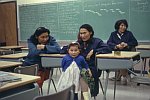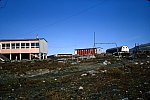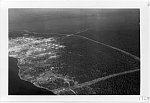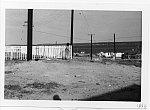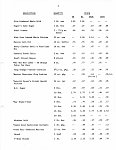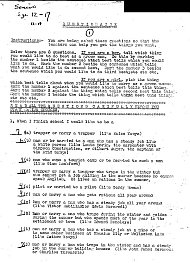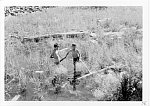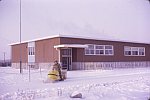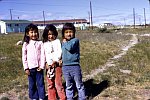Life in a Northern Town
Author: Jennifer Jozic Page 1 | Page 2 | Page 3
Schools in the North
Over half of all the people living in the North right now (2005) are under 25 years old. These young people are growing up in a part of Canada that is rapidly changing in many ways. Education plays an important role in preparing them for those changes.
Residential schools are a type of boarding school. In the past, church-run residential schools were often the only education available to children of the north.. Even very young children had to live away from their parents and attend these residential schools. They had to learn to speak English.
Today schools are an integal part of the community and there is great demand for qualified teachers, especially bilingual ones. Bilingual teachers can speak the traditional language as well as English and/or French. Northern residents hope that some of their students will become teachers themselves when they grow up and teach in their home communities.
Community schools believe it is very important to be welcoming and supportive to students and parents. Parents may choose to support community schools by helping with homework and talking to their kids about their school day. They can also be supportive by attending parent-teacher interviews and Christmas concerts, or by participating on school boards.
Some of the students may choose to prepare for careers in northern mines, oil rigs and logging operations. On the other hand, some may prefer to limit how much industry is allowed in and near their communities. Still others may decide to move to southern Canada in order to find opportunities not available to them in the North. Schooling can provide these students with the skills needed to learn a trade or perform legal, financial and negotiating tasks.
Schools are very important because they help young people cope with changes and make informed choices. At the same time there is a need to safeguard the heritage, language, stories, religion and ancestral knowledge of the northern peoples.
Black Lake: A Study about life in the North
Black Lake is a village of less than 1000 people situated on Black Lake, which is in the province of Saskatchewan. The picture at the [right/left] shows Black Lake at it appeared from the air in 1970.
Between 1969 and 1971 a group of professors and students from the University of Saskatchewan visited the community. They interviewed the residents and took hundreds of photographs in order to create reports about what life in Black Lake is like.
A nutritionist reported one example of the differences between a southern community and Black Lake. She determined that groceries were much more expensive in the North (and this is still the case). Here are two lists of groceries from the year 1970; one is from Saskatoon, and one is from Black Lake. Notice what the cost of macaroni and cheese was more than thirty years ago!
One of the researchers created a list of questions for students at Black Lake School to answer. When they compiled the results they found that students generally valued steady employment and the boys hoped to become miners, trappers and pilots. Here are two sheets of student answers, one from a boy and one from a girl.
The students were very happy to have a school but thought that traditional language and skills should be included as school activities. One of the respondents listed beadwork and sewing as subjects she would like to learn at school. She also thought that it was a good idea to have parents be a part of the school board, and to hire bilingual teachers. “We speak Chipewyan very well,” wrote this fifteen-year old student, “but we cannot write and read it unless our parents teach us our ['language'] to write and read, because our teacher does not speak Chipewyan, and he also cannot write it. We only learn English at school.”
Black Lake is still a small and remote town. The town boasts a new high school which has been named after Father Porte (see above) and the teachers are pioneering teaching methods that incorporate traditional Dene knowledge and methods. Representatives of the community are pursuing land claims that would define their possession of the surrounding landscape.
Conclusion
The north is a very special place. Where else could you watch a golf tournament under the midnight sun? Where else can you see a dog sled race across the frozen tundra? But in many ways, northern towns are like towns everywhere. The residents have the same values and needs —they work, play, and enjoy spending time with friends and family.
Maintaining schools and transportation will always be a struggle for remote communities. As always, the people of the north will continue to face these challenges with grit and determination.
Questions for review, based on this exhibit
- We can think of the North as being divided into two types of places. What are they?
- List THREE characteristics that northern communities have in common.
- How might northern people learn wilderness skills?
- Describe how a caribou parka is made. Why are they so warm?
- How do Inuit artists market their work?
- Why do Whitehorse and Dawson City look so unique?
- Youth under 25 are WHAT PERCENTAGE of the population of the north?
- Why are bilingual teachers so valuable?
- What was the cost of macaroni and cheese in Black Lake thirty years ago?
- List THREE activities you could do in the north that you are unlikely to do anywhere else.
For Further Information:
- Government of Yukon
http://www.gov.yk.ca/ - Government of Northwest Territories
http://www.gov.nt.ca/ - Government of Nunavut
http://www.gov.nu.ca/ - Indian and Northern Affairs Canada
http://www.ainc-inac.gc.ca/ - Indian and Northern Affairs Canada
Kids’ Stop
http://www.ainc-inac.gc.ca/ks/index_e.html - Dene Nation site
http://www.denenation.com/ - Canadian
Geographic Kids. Note the excellent page on the Franklin Expedition.
http://www.canadiangeographic.ca/cgKidsAtlas/default_en.asp
